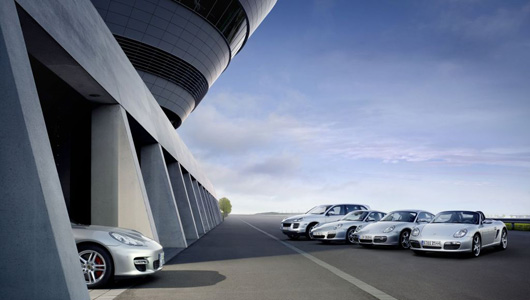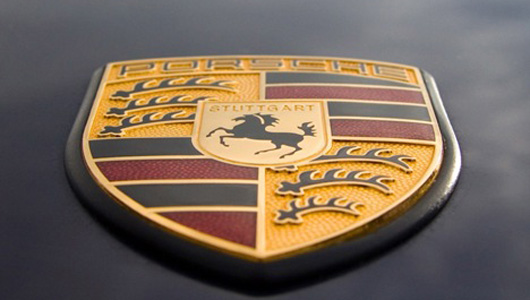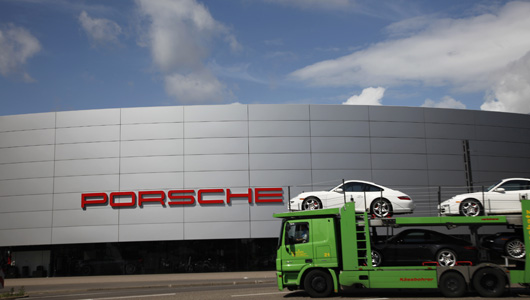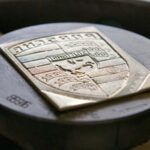When we talk about Porsche, we are talking about a brand of sporty and luxurious cars. The cars of this brand are fast, perfect in terms of features, and modern in terms of interior amenities. However, not many people know that the Porsche logo honors traditional values, the “colors of the flag”, as well as the pride of a region.
The history of Porsche began after more than 50 years of hard work and passion from its founder, Ferdinand Porsche. He was the creator of the SS sports car series and the SSK supercharged car during his position as the technical director of Benz-Daimler. During his collaboration with NSU and Volkswagen, he created the famous “Beetle” in 1932 and a series of racing cars. In 1950, after 20 years of working at his own design office, Ferdinand Porsche and his son Ferry Porsche established an independent company named Porsche, headquartered in Stuttgart, Germany.
 Porsche headquarters in Stuttgart, Germany
Porsche headquarters in Stuttgart, Germany
A year later, Porsche won the Le Mans race with its first product, the Porsche 356. This was truly a sign of a great future brand. In the same year 1951, Ferdinand Porsche passed away before the prototype of the 356 was completed, leaving the company under the management of his son, Ferry Porsche.
In 1952, while in America, Ferry delegated his trusted assistant Erwin Komenda to design the Porsche logo. Ferry’s goal at that time was to export Porsche products to the promising American market. Erwin Komenda, who had accompanied F. Porsche since 1931, was the one who designed the iconic “Beetle” of Volkswagen under the order of Adolf Hitler. Later, during Ferry’s reign, the “great master” Erwin made significant contributions with the design of the 911, a car closely associated with the Porsche name and still in production since its debut in 1964.
 Porsche has great success with fast, luxurious and modern cars
Porsche has great success with fast, luxurious and modern cars
Erwin Komenda was heavily influenced by Ferry’s ideas when designing the Porsche logo. It seems that the heads of racing car companies have a common principle when building their company’s symbol. Perhaps because of their direct involvement in sports, these companies prioritize the “colors of the flag”. Ferrari’s logo is faithful to the flag of Modena city and the national flag, which features a horse, Italy’s emblem. As for Porsche’s logo, of course, these requirements cannot be ignored.
Ferry suggested to Erwin to use the coat of arms of the Wurttemberg region, in southwestern Germany, as the background for the Porsche logo. Wurttemberg borders the autonomous state of Bavaria in the east, where the city of Stuttgart, Porsche’s capital, is located. The Wurttemberg coat of arms features a shield divided into four parts. The upper left and lower right corners depict three traditional deer antlers that have been used since ancient times.
 The coat of arms of the Wurttemberg region as the background for the Porsche logo
The coat of arms of the Wurttemberg region as the background for the Porsche logo
The remaining part is the familiar black and red stripes on the flag of the Federal Republic of Germany. At the top of the emblem, Erwin sketched the Porsche name in a harmonious shape and color, with the meaning that Porsche was, is, and will always be a part of Wurttemberg’s history.
At the center of the Porsche logo is the symbol of Stuttgart city, with a size one-third that of the large emblem, equivalent to one-ninth of the area. Overall, this proportion creates a sense of harmony, neither too large nor too small.
According to language experts, Stuttgart is a shortened form of the word “Stutengarten”, which means “stud farm” in English. The symbol and name Stutengarten partly reflect the tradition of Stuttgart, a place with prosperous horse farms along the banks of the Neckar River. There is a theory that the image of the noble steed drawn by Italian air force hero Francesco Baracca on the side of his aircraft was somewhat inspired by these horse farms as he flew over Stuttgart, and this horse continued to inspire the symbol of Ferrari.
Porsche’s fellow companions in Stuttgart are Mercedes-Benz and Maybach, but only Ferry had the idea of a simple combination of hometown symbols. His goal was to allow American consumers to read Porsche’s history just by looking at the logo. This also means ensuring the quality of Porsche products because, according to Ferry’s philosophy, “nothing makes others believe in you more than your roots”. After being approved after a year, the Porsche logo officially appeared on the steering wheels of the 1953 car models.
For over 60 years, despite going through ups and downs, the emblem still appears on Porsche’s excellent products. Though Porsche was born later than the major German car manufacturers, it has achieved success in its own way. The leaders believe that the strong, confident, luxurious, and attractive character based on traditional values has helped Porsche and its emblem overcome the most difficult periods in the company’s history and develop to the present.
Thao Anh (source: TTTD)
How is the Porsche logo created?
Porsche has recently released a video showcasing the process of restoring vintage logos on their iconic Porsche 356 and 911 models. The video highlights the meticulous craftsmanship and attention to detail that goes into preserving the classic logos. This restoration process not only brings back the original charm of these historic vehicles, but also pays tribute to Porsche’s rich heritage. Watch the video to witness the careful restoration of these vintage logos, a testament to Porsche’s commitment to quality and tradition.
Porsche Icon: Celebrating 60 Years of Excellence
When Porsche is mentioned, it signifies a renowned brand of high-performance cars and luxurious vehicles. Porsche vehicles are synonymous with speed, impeccable characteristics, and state-of-the-art interior comforts. Yet, few individuals are acquainted with the fact that the Porsche emblem also embodies and honors timeless principles, local ardor, and cultural legacy.
The creation process of the Porsche logo
Porsche has recently unveiled a captivating video that unveils the journey of reviving vintage logos on their legendary Porsche 356 and 911 models. The video captivates the audience by showcasing the mesmerizing craftsmanship and meticulous attention to detail involved in preserving these timeless logos. Through the restoration process, the original allure of these iconic vehicles is brilliantly revived, paying homage to Porsche’s illustrious legacy. Embark on this captivating visual journey and witness the intricate restoration of these vintage logos, a testament to Porsche’s unwavering dedication to excellence and heritage.














































